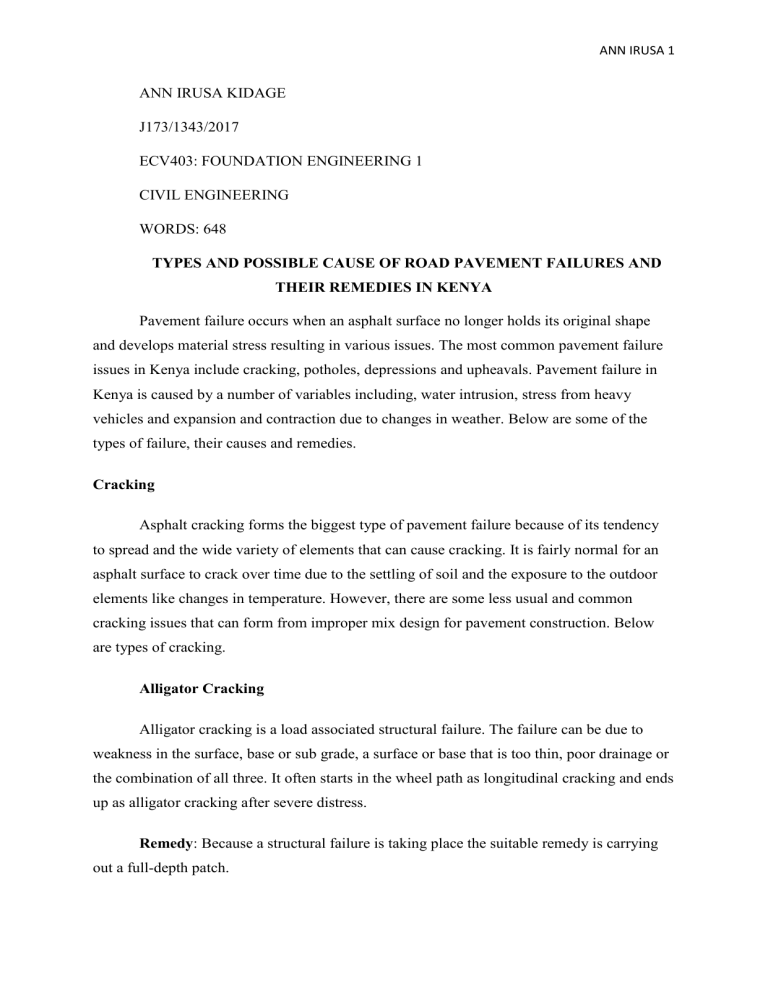
ANN IRUSA 1 ANN IRUSA KIDAGE J173/1343/2017 ECV403: FOUNDATION ENGINEERING 1 CIVIL ENGINEERING WORDS: 648 TYPES AND POSSIBLE CAUSE OF ROAD PAVEMENT FAILURES AND THEIR REMEDIES IN KENYA Pavement failure occurs when an asphalt surface no longer holds its original shape and develops material stress resulting in various issues. The most common pavement failure issues in Kenya include cracking, potholes, depressions and upheavals. Pavement failure in Kenya is caused by a number of variables including, water intrusion, stress from heavy vehicles and expansion and contraction due to changes in weather. Below are some of the types of failure, their causes and remedies. Cracking Asphalt cracking forms the biggest type of pavement failure because of its tendency to spread and the wide variety of elements that can cause cracking. It is fairly normal for an asphalt surface to crack over time due to the settling of soil and the exposure to the outdoor elements like changes in temperature. However, there are some less usual and common cracking issues that can form from improper mix design for pavement construction. Below are types of cracking. Alligator Cracking Alligator cracking is a load associated structural failure. The failure can be due to weakness in the surface, base or sub grade, a surface or base that is too thin, poor drainage or the combination of all three. It often starts in the wheel path as longitudinal cracking and ends up as alligator cracking after severe distress. Remedy: Because a structural failure is taking place the suitable remedy is carrying out a full-depth patch. ANN IRUSA 2 Block Cracking Block cracks appear in the shape of large interconnected rectangles. Block cracking is caused by shrinkage of the asphalt pavement due to an inability of asphalt binder to expand and contract with heating and cooling. The causes include mix was mixed and placed too dry, Fine aggregate mix with low penetration asphalt & absorptive aggregates, poor choice of asphalt binder in the mix design, or aging dried out asphalt. Remedy: Less severe cracks of 0.5 inches or less can be sealed to prevent moisture from entering into the sub grade. More severe cracks should be fixed by removing the cracked pavement layer and replacing it with an overlay. Joint Reflection Cracks These are cracks in a flexible pavement overlay of a rigid pavement. They occur directly over the underlying rigid pavement joints. Joint reflection cracking does not include reflection cracks that occur away from an underlying joint or from any other type of base. Remedy: For less severe cracks, less than 0.5 inch, crack sealing will prevent the further entry of moisture into the subgrade. If the cracks are more severe the removal of the cracked pavement layer followed by an overlay may be required. Pot Holes These are small, bowl-shaped depressions in the pavement surface that penetrate through the asphalt layer down to the base course. Potholes mainly result from moisture infiltration and most cases end result of untreated alligator cracking. As alligator cracking becomes severe, the interconnected cracks create small chunks of pavement that get dislodged when the ground is disturbed e.g. by vehicles passing over them. This creates holes in the pavement forming pothole. Remedy: The solution to potholes is only carrying out a full depth replacement patch following the layers used in the pavement construction Depressions ANN IRUSA 3 Depressions are localized pavement surface areas with slightly lower elevations than the surrounding pavement. Depressions are very noticeable after a rain when they fill with water. Remedy: Depending on the severity of the depression the asphalt may have to be removed and replaced. This applies to severe depressions. Less severe depressions can be fixed by applying a thin surface patch or infrared patch. Upheaval Upheaval is a localized upward movement in a pavement due to swelling of the subgrade. This can be due to expansive soils that swell due to moisture Remedy: This can only be solved by full depth patch


